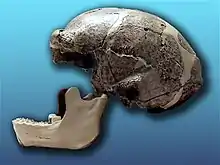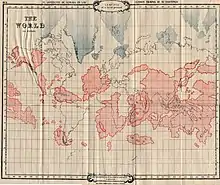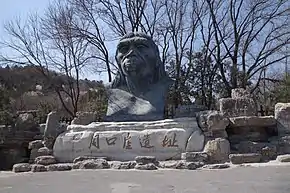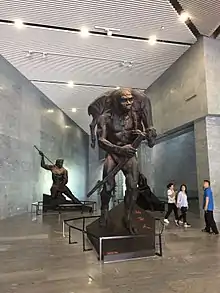Peking Man
Peking Man (Homo erectus pekinensis, formerly known by the junior synonym Sinanthropus pekinensis) is a group of fossil specimens of Homo erectus, dated from roughly 750,000 years ago,[1][2] discovered in 1929–37 during excavations at Zhoukoudian (Chou K'ou-tien) near Beijing (at the time spelled Peking), China.
| Peking man | |
|---|---|
 | |
| First cranium of Homo erectus pekinensis (Sinanthropus pekinensis) discovered in 1929 in Zhoukoudian, today missing (replica) | |
| Scientific classification | |
| Kingdom: | Animalia |
| Phylum: | Chordata |
| Class: | Mammalia |
| Order: | Primates |
| Suborder: | Haplorhini |
| Infraorder: | Simiiformes |
| Family: | Hominidae |
| Subfamily: | Homininae |
| Tribe: | Hominini |
| Genus: | Homo |
| Species: | |
| Subspecies: | †H. e. pekinensis |
| Trinomial name | |
| Homo erectus pekinensis (Black, 1927) | |
| Synonyms | |
|
Sinanthropus pekinensis Black, 1927 | |
Between 1929 and 1937, 15 partial crania, 11 mandibles, many teeth, some skeletal bones and large numbers of stone tools were discovered in the Lower Cave at Locality 1 of the Peking Man site at Zhoukoudian. Their age is estimated to be between about 750,000 and 300,000 years old.
Most of the early studies of these fossils were conducted by Davidson Black until his death in 1934. Pierre Teilhard de Chardin took over until Franz Weidenreich replaced him and studied the fossils until he left China in 1941. The original fossils disappeared in 1941, but excellent casts and descriptions remain.
Taxonomy
Research history
In 1923, Andersson and Austrian palaeontologist Otto Zdansky found 2 human teeth in the Zhoukoudian site near Beijing (the romanisation of Beijing is Peking), but only reported them in 1926. To continue excavation of the site, Canadian palaeoanthropologist Davidson Black founded the Cenozoic Research Laboratory which discovered a skull in 1929. After Black's sudden death in 1934, Jewish-German anthropologist Franz Weidenreich carried on his study of the Zhoukoudian.[3]
In 1941, to safeguard them during the war, the Zhoukoudian human fossils—representing at least 40 different individuals—and artefacts were deposited into 2 wooden footlockers and were to be transported by the United States Marine Corps from the Peking Union Medical College to the SS President Harrison which was to dock at Qinhuangdao Port (near the Marine basecamp Camp Holcomb), and eventually arrive at the American Museum of Natural History in New York City. Unfortunately, the ship was attacked by Japanese warships en route to Qinhuangdao, and ran aground. Though there have been many attempts to locate the crates—including offering large cash rewards—it is unknown what happened to them after they left the college. Marine Richard Bowen recalled finding a box filled with bones while digging a foxhole one night next to some stone barracks in Qinhuangdao, while the city was under siege by the CCP Eighth Route Army who were under fire from Nationalist gunboats (a conflict of the Chinese Civil War). According to Mr. Wang Qingpu who had written a report for the Chinese government on the history of the port, if Bowen's story is accurate, the most probable location of the bones is 39°55′4″N 119°34′0″E underneath roads, a warehouse, or a parking lot.[4] Four of the teeth from the original excavation period are still in the possession of the Paleontological Museum of Uppsala University in Sweden.[5]
The war had halted excavation of the Zhoukoudian from 1941 until after the formation of the People's Republic of China in 1949.[3] In 1960, the lab was converted into an independent organisation as the Institute of Vertebrate Paleontology and Paleoanthropology (IVPP), a division of the Chinese Academy of Sciences, and was headed by Chinese palaeoanthropologists Yang Zhongjian, Pei Wenzhong, and Jia Lanpo.
Out of Asia theory

Despite what Charles Darwin had hypothesised in his 1871 Descent of Man, many late-19th century evolutionary naturalists postulated that Asia (instead of Africa) was the birthplace of humankind as it is midway between Europe and America, providing optimal dispersal routes throughout the world. Among the latter was Ernst Haeckel who argued that the first human species (which he proactively named "Homo primigenius") evolved on the now-disproven hypothetical continent "Lemuria" in what is now Southeast Asia, from a genus he termed "Pithecanthropus" ("ape-man"). "Lemuria" had supposedly sunk below the Indian Ocean, so no fossils could be found to prove this. Nevertheless, Haeckel's model inspired Dutch scientist Eugène Dubois to join the Dutch East India Company and search for his "missing link" in Java. He found a skullcap and a femur (Java Man) which he named "P. erectus" (using Haeckel's hypothetical genus name) and unfruitfully attempted to convince the European scientific community that he had found an upright-walking ape-man dating to the late Pliocene or early Pleistocene, who dismissed his findings as some kind of malformed non-human ape. Dejected, Dubois fully withdrew from anthropology by the turn of the century.[3]
Instead, in regard to the ancestry of Far Eastern peoples, racial anthropologists had long placed the origin of Chinese civilisation in the Near East. The most popular theory in China at the time was that proposed by Albert Terrien de Lacouperie in 1894 who drew parallels between the hexagrams from the Classical Chinese I Ching and the Near Eastern script cuneiform, as well as Mesopotamian and Chinese mythologies (notably between the Elamite god Nahundi and the first Chinese emperor Huangdi). Other Western theories include China descending from Ancient Egypt due to similarities between Chinese characters and Egyptian hieroglyphs. Terrien de Lacouperie believed that, due to having a common ancestor with the superior Europeans, the Han Chinese people progressively became more and more inferior, and that all Chinese achievements were simply inherited from Western Civilisation. His theory was criticised by European sinologists, but was nonetheless adapted by Jiang Zhiyou, and was used by late Qing Dynasty "national essence" scholars to push the racial superiority of the Han people over the Manchu people (the Manchu were the ruling people of the Qing dynasty) as the former was closely allied with the powerful European races, whereas the latter descended from northern "barbarians". The narrative formed that Huangdi was the ancestor of all Han people, and conquered the land for his descendants, advocating for the fall of the Qing Dynasty by pushing some natural state of Han dominance over the land.[3]
These claims were overturned by the 1920s in the face of the New Culture Movement, emphasising Chinese nationalism (about a decade after the Qing Dynasty fell to the Republic of China). In 1921, Swedish geologist Johan Gunnar Andersson working as the mining advisor for the Ministry of Agriculture and Commerce identified the Yangshao culture with similar pottery work to older Near Eastern settlements, and, echoing some elements of Terrien de Lacouperie's earlier hypotheses, concluded a western origin for Chinese culture. While his model was popular in the West, Andersson was met with much derision by Eastern scholars for being too Eurocentric. Instead, an origin for the human species in Central Asia was much more accepted, championed primarily by American palaeontologist Henry Fairfield Osborn and his apprentice William Diller Matthew. They believed that Asia was the "mother of continents" and the rising of the Himalayas and Tibet and subsequent drying of the region forced human ancestors to become terrestrial and bipedal, and that populations which retreated to the tropics–namely Dubois' Java Man and the "Negroid race"—substantially regressed. They also rejected Raymond Dart's South African Taung child (Australopithecus africanus) as a human ancestor, favouring the hoax Piltdown Man from Britain.[3]
Peking Man and Sinocentricism

In 1927, Black classified newly discovered human remains from the Zhoukoudian into a new genus and species as "Sinanthropus pekinensis". The Peking Man, with a brain volume much larger than living apes, was used to further invalidate African or European origin models. Peking Man's importance in human evolution was championed by geologist Amadeus William Grabau in the 1930s, who pushed that the lifting of the Himalayas caused the emergence of proto-humans ("Protanthropus") in the Miocene, who then dispersed during the Pliocene into the Tarim Basin in Northwest China where they learned to control fire and make stone tools, and then went out to colonise the rest of the Old World where they evolved into "Pithecanthropus" in Southeast Asia, "Sinanthropus" in China, "Eoanthropus" (Piltdown Man) in Europe, and "Homo" in Africa (again believing tropical environments promote mental degradation, degeneration theory). To explain the paucity of stone tools in Asia compared to Europe (an apparent contradiction if humans had occupied Asia for longer), he also stated that Pleistocene Central Asia was too cold to permit back-migration by early modern humans or Neanderthals until the Neolithic. The Central Asia model was the leading consensus of the time.[3]
Peking Man became an important matter of national pride, and was used to extend the antiquity of the Chinese people and the occupation of the region to 500,000 years ago, with discussions of human evolution becoming progressively Sinocentric. In the 1930s, Weidenreich began arguing that Peking Man was ancestral to the "Mongoloid race", though other scientists working on the site made no such claims. The sentiment that all Chinese ethnic groups—including the Han, Tibetan, and Mongols—were indigenous to the area for such a long time became more popular during the Second Sino-Japanese War and the occupation of China by Japan. This was notably perpetuated by ethnologist Li Guangming and sociologist Chen Zhengmo. By the 1940s, Andersson recanted his Western origin hypothesis and instead believed that the Yangshoa culture may have influenced Western pottery instead of the other way around.[3]
In 1950, Ernst Mayr had entered the field of anthropology, and, surveying a "bewildering diversity of names," decided to subsume human fossils into 3 species of Homo: "H. transvaalensis" (the australopithecines), H. erectus (including "Sinanthropus", "Pithecanthropus", and various other putative Asian, African, and European taxa), and Homo sapiens (including anything younger than H. erectus, such as modern humans and Neanderthals). Mayr defined them as a sequential lineage, with each species evolving into the next (chronospecies). Though later Mayr changed his opinion on the australopithecines (recognising Australopithecus), his more conservative view of archaic human diversity became widely adopted in the subsequent decades.[6]
By the late 20th century, human evolution had become Afrocentric with the gradual acceptance of Australopithecus as human ancestors, and consequent marginalisation of Peking Man.[3] Nonetheless, Peking Man's ancestral position is still widely maintained among Chinese scientists—such as palaeoanthropologists Wu Xinzhi and Gao Xin–who subscribe to Weidenreich's multiregional hypothesis, wherein archaic humans such Peking Man directly evolved or were absorbed into modern humans in their respective locations (so according to this, Peking Man has lent some ancestry to modern Chinese populations).[3] On this matter, palaeogenetic analyses—the first in 2010—have reported that all humans whose ancestry lies beyond Subsaharan Africa contain genes from the archaic Neanderthals and Denisovans (Subsaharan Africans display archaic introgression from an unidentified ghost lineage), indicating early modern humans interbred with archaic humans. These 2 archaic species in turn interbred with other archaic species even farther removed from modern humans.[7][8] The few Denisovan fossils bear some resemblance to Peking Man.[9]
Fossils
The most complete fossils, all of which were portions of the skullcap (calvariae), are:
- Skull II, discovered at Locus D in 1929 but only recognized in 1930, is an adult or adolescent with a brain size of 1030 cc.
- Skull III, discovered at Locus E in 1929 is an adolescent or juvenile with a brain size of 915 cc.
- Skulls X, XI and XII (sometimes called LI, LII and LIII) were discovered at Locus L in 1936. They are thought to belong to an adult man, an adult woman and a young adult, with brain sizes of 1225 cc, 1015 cc and 1030 cc respectively.[10]
- Skull V: two cranial fragments were discovered in 1966 which fit with (casts of) two other fragments found in 1934 and 1936 to form much of a skullcap with a brain size of 1140 cc. These pieces were found at a higher level, and appear to be more modern than the other skullcaps.[11]
A number of fossils of modern humans were also discovered in the Upper Cave at the same site in 1933.
Classification
The first specimens of Homo erectus had been found in 1891 by Eugène Dubois in Java, dubbed "Java Man" , but were at first dismissed by many as the remains of a deformed ape. The discovery of the great quantity of finds at Zhoukoudian put this to rest and Java Man, who had initially been named Pithecanthropus erectus, was transferred to the genus Homo along with Peking Man.[12]
Contiguous findings of animal remains and evidence of fire and tool usage, as well as the manufacturing of tools, were used to support H. erectus being the first "faber" or tool-worker. The analysis of the remains of "Peking Man" led to the claim that the Zhoukoudian and Java fossils were examples of the same broad stage of human evolution. The specimens of Lantian Man, discovered in 1963 and published in 1964, were added to the genus as Sinanthropus lantianensis.[13]
Lantian Man was later reclassified as a subspecies of Homo erectus, and the genus Sinanthropus is now disused. Both Peking Man and Java Man are now classified as members of Homo erectus, although Java Man, at about 1.5 to 0.4 million years, includes fossils that are significantly older than Peking Man, at about 0.7 to 0.4 million years.
In 1985, Lewis Binford claimed that Peking Man was a scavenger, not a hunter.
Relation to modern humans

Franz Weidenreich (1873 – 1948) considered Peking Man as a human ancestor and specifically an ancestor of the Chinese people,[14] as seen in his original multiregional model of human evolution in 1946.[15] This view was widely accepted, and in the 1950s it was considered a human ancestor at least by some scholars.[16] Chinese scholarly literature in the 1950s included the view was that Peking Man in some ways resembled modern Europeans more than modern Asians,[17] a position that was partly ideological or chauvinistic, preferring to attribute "primitive" traits to Europeans rather than to Chinese.[18]
During the 1980s to 2000s, the multiregional origin model was eclipsed by widespread acceptance of recent African origin, although a 1999 study noted a perceived continuity in skeletal remains,[19] and a minority view even attempted to derive modern humans from China rather than Africa.[20] Since the 2010s, the question has been re-opened in terms of archaic admixture to the modern human lineage.
East Asians are now known to be partially descended from "Denisovans" (or "Asian Neanderthals"), which show morphological similarities both to certain younger East Asian fossils such as Penghu 1 and to Chinese specimens of Homo erectus.
See also
- Anthropopithecus
- List of fossil sites (with link directory)
- List of hominina fossils with images
Notes
- Paul Rincon (11 March 2009). "'Peking Man' older than thought". BBC News. Retrieved 22 May 2010.. A 26Al/10Be dating published in 2009 suggests they are in the range of 680,000–780,000 years old: Shen, G; Gao, X; Gao, B; Granger, De (March 2009). "Age of Zhoukoudian Homo erectus determined with (26)Al/(10)Be burial dating". Nature. 458 (7235): 198–200. Bibcode:2009Natur.458..198S. doi:10.1038/nature07741. ISSN 0028-0836. PMID 19279636. S2CID 19264385.
- "'Peking Man' older than thought". BBC News. 11 March 2009. Retrieved 22 May 2010.
- Hsiao-Pei, Y. (2014). "Evolutionary Asiacentrism, Peking Man, and the Origins of Sinocentric Ethno-Nationalism". Journal of the History of Biology. 47: 585–625. doi:10.1007/s10739-014-9381-4.
- Berger, L. R.; Liu, W.; Wu, X. (2012). "Investigation of a credible report by a US Marine on the location of the missing Peking Man fossils". South African Journal of Science. 108 (3–4). doi:10.4102/sajs.v108i3/4.1122.
- Frängsmyr (2012), p. 60.
- Schwartz, J. H.; Tattersall, I. (2010). "Fossil evidence for the origin of Homo sapiens". American Journal of Physical Anthropology. 143 (S51): 96–98, 101–103. doi:10.1002/ajpa.21443. PMID 21086529.
- Waddell, P. J. (2013). "Happy New Year Homo erectus? More evidence for interbreeding with archaics predating the modern human/Neanderthal split" (PDF). Quantitative Biology: 2–3. arXiv:1312.7749.
- Fahu Chen; Frido Welker; Chuan-Chou Shen; Shara E. Bailey; Inga Bergmann; Simon Davis; Huan Xia; Hui Wang; Roman Fischer; Sarah E. Freidline; Tsai-Luen Yu; Matthew M. Skinner; Stefanie Stelzer; Guangrong Dong; Qiaomei Fu; Guanghui Dong; Jian Wang; Dongju Zhang; Jean-Jacques Hublin (2019). "A late Middle Pleistocene Denisovan mandible from the Tibetan Plateau" (PDF). Nature. 569 (7756): 409–412. Bibcode:2019Natur.569..409C. doi:10.1038/s41586-019-1139-x. PMID 31043746. S2CID 141503768.
- E. Andrew Bennett; Isabelle Crevecoeur; Bence Viola; Anatoly P. Derevianko; Michael V. Shunkov; Thierry Grange; Bruno Maureille; Eva-Maria Geigl (2019). "Morphology of the Denisovan phalanx closer to modern humans than to Neanderthals". Science Advances. 5 (9): eaaw3950. doi:10.1126/sciadv.aaw3950. PMC 6726440. PMID 31517046.
- Weidenreich (1943), pp. 5–7.
- Jia & Huang (1990).
- Melvin, Sheila (11 October 2005). "Archaeology: Peking Man, still missing and missed". International Herald Tribune. Retrieved 20 April 2008.
The discovery also settled a controversy as to whether the bones of Java Man – found in 1891 – belonged to a human ancestor. Doubters had argued that they were the remains of a deformed ape, but the finding of so many similar fossils at Dragon Bone Hill silenced such speculation and became a central element in the modern interpretation of human evolution.
- Woo, J. (1964). "Mandible of Sinanthropus lantianensis". Current Anthropology. 5 (2): 98–101. doi:10.1086/200457.
- Schmalzer (2008), p. 98.
- Alan R. Templeton. "Genetics and recent human evolution" (PDF). Archived from the original (PDF) on 12 May 2013. Retrieved 13 August 2010. Cite journal requires
|journal=(help) - Schmalzer (2008), p. 97.
- Zhu Xi, Women de zuxian [Our Ancestors] (Shanghai: Wen hua shenghuo chubanshe, 1950 [1940]), 163. (reference by Schmalzer, pg 97)
- Peking Man and the Politics of Paleoanthropological Nationalism in China, Barry Sautman in The Journal of Asian Studies Vol. 60, No. 1 (Feb., 2001), pp. 95–124
- Shang; Tong, H.; Zhang, S.; Chen, F.; Trinkaus, E.; et al. (1999). "An early modern human from Tianyuan Cave, Zhoukoudian, China". Proceedings of the National Academy of Sciences. 104 (16): 6573–8. Bibcode:2007PNAS..104.6573S. doi:10.1073/pnas.0702169104. PMC 1871827. PMID 17416672.
- Geoffrey G. Pope, "Craniofacial Evidence for the Origin of Modern Humans in China", Yearbook of Physical ANthropology 35 (1992), 243–298.
References and further reading
- Aczel, Amir D. (2007). The Jesuit and the Skull: Teilhard de Chardin, Evolution, and the Search for Peking Man. Riverhead Books.
- Carroll, Owen (1981). The Religious Implications of the Choukoutien Lower Cave. James Press.
- Frängsmyr, Tore (2012). "Peking Man: New Light on an Old Discovery". In Buchwald, Jed Z. (ed.). A Master of Science History: Essays in Honor of Charles Coulston Gillispie. Springer. pp. 49–62. ISBN 978-94-007-2627-7.
- Hooker, Jake. The Search for the Peking Man. Archaeology magazine March/April 2006.
- Jia, Lanpo; Huang, Weiwen (1990). The Story of Peking Man: From Archaeology to Mystery. Oxford University Press.
- Schmalzer, Sigrid (2008). The People's Peking Man: Popular Science and Human Identity in Twentieth-Century China. University of Chicago Press.
- Weidenreich, Franz (1943). The Skull of Sinanthropus pekinensis; A Comparative Study on a Primitive Hominid Skull. Geological Survey of China.
- Wu, R.; Lin, S. (1983). "Peking Man". Scientific American. 248 (6): 86–94. doi:10.1038/scientificamerican0683-86.
External links
| Wikimedia Commons has media related to Peking Man. |